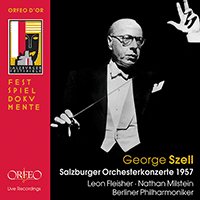Leon Fleisher
The son of Russian and Polish immigrants who had settled in San Francisco, Leon Fleisher received his first piano lessons from Lev Shorr. His early years were spent as a prodigy, first playing in public at the age of seven, and with a symphony orchestra two years later. Schnabel heard him at this time and accepted him as a pupil, even though he was ten years old and Schnabel did not like prodigies. The boy went to Italy for this purpose, until World War II caused Schnabel to move to New York. The Fleishers also moved to New York and whilst young Leon was engaged in musical study he had no regular schooling, but studied with a tutor. The ten years spent with Schnabel were of the greatest influence on Fleisher.
At fourteen he made his professional debut with the San Francisco Symphony Orchestra and conductor Pierre Monteux, who championed Fleisher for many years. They played Liszt’s Piano Concerto No. 2 in A major, and the following year in New York Fleisher played Brahms’s Piano Concerto No. 1 in D minor Op. 15 with Monteux and the New York Philharmonic. Success came very early to Fleisher who, by the age of eighteen, had played recitals at Carnegie Hall and many orchestral performances with the major American symphony orchestras. However, as with many prodigies, Fleisher began to have problems in his later teens, which affected his playing. This was coupled with the fact that Schnabel decided to stop teaching Fleisher, and after ten formative years, this must have been an unwelcome change in his life.
Fleisher went to Paris for three years and whilst there, entered the Queen Elisabeth Competition in Brussels. His taking of the first prize revived his career immediately, and he toured Europe, Canada and North and South America.
After joining the faculty of the Peabody Conservatory, Fleisher was awarded a grant by the Ford Foundation to commission a work. He chose composer Leon Kirchner, who wrote for him his Piano Concerto No. 2. Fleisher recorded Kirchner’s Piano Sonata (1948) in 1962.
An extremely successful career of ten years was brought to an abrupt halt in 1965. Fleisher had been noticing weaknesses in his right hand, more evident after practising for seven or eight hours a day. He became unable to perform in public, so began to learn works written for left hand alone and also turned to conducting. In 1968 he formed the Theater Chamber Players in Washington DC and became conductor of the Annapolis Symphony Orchestra, and in 1973 became associate director of the Baltimore Symphony Orchestra, resigning in 1978 to be guest conductor with other orchestras. After an operation on his hand in the early 1980s, Fleisher played the Variations Symphoniques by César Franck in public, but realised that he could not sustain public performance with both hands and cancelled the rest of his appearances. From then until now he has concentrated on works for left hand although he did not play a solo recital in public again until 1990. Lukas Foss wrote a Piano Concerto for Left Hand which Fleisher premièred in 1994 at Tanglewood with Seiji Ozawa. In 1995 Fleisher returned to playing with both hands thanks to a new therapy based on a massaging technique. He became Mellon Professor of Music at the Peabody Conservatory and in 1990 was awarded the John Hopkins University President’s Medal in recognition of his thirty years teaching. His pupils include Louis Lortie and André Watts. He has given master-classes in Europe and America and now concentrates on teaching at the Curtis and Peabody Schools in America and the Royal College of Music in Toronto.
In the late 1950s Fleisher made a series of recordings for CBS with the Cleveland Orchestra and George Szell. They recorded all the concertos of Beethoven, Brahms, Grieg and Schumann, and Mozart’s in C major K. 503, as well as Rachmaninov’s Rhapsody on a theme of Paganini Op. 43 and Franck’s Variations Symphoniques. Unusual solo repertoire recorded at this time includes Weber’s Piano Sonata No. 4 in E minor Op. 70, Copland’s Piano Sonata, and Barcarolles by Ned Rorem. Most of this music is a world away from Schnabel, and in some of the Romantic concertos Fleisher plays much more in the mould of Horowitz and his own contemporaries. A recording of Liszt’s Piano Sonata in B minor from 1959 is fast and furious where speed seems to be the most important factor.
New recordings made for Sony in the 1990s include a disc of works for left hand and orchestra with the Boston Symphony Orchestra and Seiji Ozawa which contains a fine reading of Ravel’s Concerto for Left Hand which Fleisher had previously recorded for Vanguard in 1982 with the Baltimore Symphony Orchestra. Another disc recorded in 1991 includes the six Études for Left Hand by Saint-Saëns Op. 135, a Godowsky arrangement of music from Strauss’s Der Zigeunerbaron and some twentieth-century works by Takács and Robert Saxton. There is also an excellent disc of music for chamber ensemble and left hand by Korngold and Schmitt.
© Naxos Rights International Ltd. — Jonathan Summers (A–Z of Pianists, Naxos 8.558107–10).

















